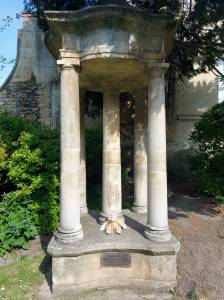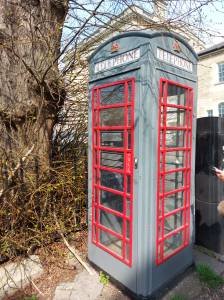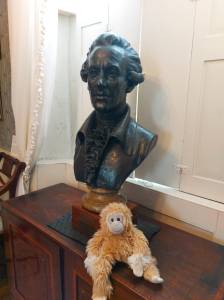Once upon a time, around the 9th century BC, Prince Bladud contracted leprosy. His father, Ludhudibras, banished Bladud from the court and sent him to work as a country swineherd. Accepting his fate, Prince Bladud took good care of his pigs, noticing that when the animals wallowed in the steamy, muddy swamp at the bottom of the valley, they emerged cleansed of their warts and sores. Braving the mucky water, Bladud plunged into the stream and emerged without a blemish. His leprosy had vanished, and his father welcomed him back home. The news spread of the miracle, and soon, a small town developed around the thermal waters, building the foundations of the city of Bath.
The water that cured Prince Bladud is the same water that fills the city of Bath’s top tourist attraction. The Roman Baths or thermae date to around 60-70 AD, during the first few decades of the Roman occupation of Britain. These baths attracted people from far and wide who wished to sample the healing power of the water. The city became known as Aquae Sulis (Waters of Sulis) due to the Roman belief the hot spring that supplied the water belonged to the goddess Sulis Minerva. For this reason, the Romans also built a temple on the site.
As with most Roman buildings, the baths succumbed to the elements. Fortunately, parts of the original foundations survived, upon which 18th-century architects reconstructed some of the walls and columns. Today, swimming in the waters, which have turned green due to algae, is not possible, but the baths are open to the public as a museum. Next door, the Grand Pump Room sells samples of the curative water to taste – something that gets mixed reactions from visitors.
The water in the Roman Baths may be many hundreds or even thousands of years old. It originally fell as rain on the Mendip Hills and percolated down through limestone aquifers measuring a depth of 2,700-4,300 metres (8,900-14,100 ft). The deeper the water travelled, the higher the temperature rose, reaching between 64 and 96 degrees Celsius. Under the pressure of the limestone, the water eventually rises back up to the surface through cracks, forming heated springs. Scientists have studied this phenomenon to develop enhanced geothermal systems.
Around 1,106,400 litres of water rise every day to fill the baths. This is approximately 13 litres per second. It rises from the Pennyquick fault, which thanks to Roman engineering, flows directly to the bathing pools. There are an estimated 43 minerals in the water, including calcium, sulphates, sodium and chloride. There are also some traces of iron, which causes orange stains on rocks and stone. Sometimes, the water may appear to bubble. This is caused by gases escaping.
Archaeological evidence suggests the site of the baths was a worship centre for the Celts. They dedicated the springs to the goddess Sulis, a life-giving mother goddess, who the Romans associated with Minerva, the goddess of wisdom. When the Romans invaded, they kept the name Sulis, as seen in the name Aquae Sulis, but frequently referred to the goddess as Minerva-Sulis or Sulis Minerva. Before constructing the bathing complex, which took around 300 years, the Romans built and dedicated a temple to the goddess.
Builders began by creating a wooden foundation in the mud surrounding the thermal spring, then constructed a stone chamber lined with lead. In the 2nd century AD, a wooden barrel-vaulted ceiling enclosed the building, dividing it into several sections, including a caldarium (hot bath), tepidarium (lukewarm bath), and frigidarium (cold bath). Bathers usually started in the tepidarium, heated by underground lead pipes, which directed water from the spring into the baths. Here, the bathers acclimatised to the heat before moving on to the considerably warmer caldarium. The rich usually brought attendants to rub their bodies with fragrant oils before taking a plunge into the freezing water in the frigidarium to close the pores.
Bathing was not the only activity available at the baths. Alcoves provided spaces for business meetings, philosophical discussions, or a place to meet friends. Evidence suggests visitors played board games, gambled and consumed food and drink. In other areas, musicians performed while people received certain treatments, such as manicures and pedicures.
Many Roman towns contained a bathing house, but people travelled far and wide to experience the curative waters provided by Sulis Minerva. People with various ailments travelled to Bath to drink the water or submerge their ailing bodies. Others visited to ask the goddess for advice or vengeance. Over 130 lead or pewter curse tablets have been discovered, asking Sulis Minerva to punish a wrongdoer. Many of these relate to petty crimes, such as the theft of a towel. Often, the accuser did not know who committed the crime, but they believed the goddess would know and mete out punishment accordingly.
Excavation has also revealed thousands of coins, jewellery, dishes and cups, many containing a dedication to Sulis Minerva. When not asking the goddess for requests, people gave sacrifices and gifts. Unlike contemporary religions, where gods and goddesses are worshipped across the world, the Roman baths and temple became the point at which the human world could communicate with the presiding deity.
Not much remains of the Temple of Sulis Minerva, which stood next to the baths. During excavations and sewage works, a handful of artefacts have been unearthed, which are now in the Roman Baths museum. A gilded bronze head belonging to a statue of Sulis Minerva was discovered by workers in 1727. Its body has never been found, but it is believed it once wore a tall Corinthian helmet. Other items once belonging to the temple include a relief carving of the goddess wearing a gorgon mask and parts of a carved pediment, which may also feature a gorgon. According to Greek mythology, the hero Perseus killed the gorgon Medusa and gifted her head to the goddess Athena, the Greek equivalent of Minerva.
The baths remained popular for many years, permitting both men and women entry. At one time, men and women could not visit together, but further construction provided separate changing areas for the different sexes. Builders also raised the floors of the baths to escape the rising water levels caused by the frequent flooding of the nearby River Avon. These floods also sent mud into the water system, which accumulated in the Sacred Spring. The higher the bath floors, the further away they got from the underground heating, rendering it useless. The number of visitors dropped rapidly, and the inhabitants of Aquae Sulis gave up the losing battle against the floods. Eventually, mud and debris found their way into the temple, damaging the walls and causing the building to collapse. The baths suffered a similar fate, and the ceiling crashed into the swamp below, where people once bathed in the thermal water.
The story of the Roman Baths did not end there. During the 12th century, John of Tours (d.1122), the Bishop of Wells, built a new bath over the once-Sacred Spring. The pool became known as the King’s Pool and is where Anne of Denmark (1574-1619), the wife of King James I (1566-1625), bathed on 19th May 1613 on the recommendation of the court physician, Théodore de Mayerne (1573-1655). Anne returned in 1615 to bathe in the newly constructed Queen’s Bath, decorated with the inscription Anna Regnum Sacrum (Anne’s Sacred Kingdom).
During the 18th century, father and son architects John Wood, the Elder (1704-54) and John Wood, the Younger (1728-82), designed a new building to house the King and Queen Baths. Basing the design on the original Roman Baths, the neoclassical building also contains the Grand Bath, which the general public used. Next door, they built the Grand Pump Room, where visitors could “take the waters”, in other words, drink it, or attend social functions.
Further expansion of the baths continued during the Victorian era. During the late 19th century, statues of Roman Emperors and Governors of Roman Britain were placed on the open terrace surrounding the Grand Bath. Over time, the elements have eroded some features, particularly the faces, but a new protective wash prevents further damage. The statues represent Julius Caesar, Emperor Claudius, Emperor Vespasian, Governor Ostorius Scapula, Governor Suetonius Paulinus, Governor Julius Agricola, the Head of Roma (symbolising Rome), Emperor Hadrian and Emperor Constantine the Great. These men lived between 100 BC and 337 AD, and all had significant connections with Britain, or Britannia, as it was then known.
The Roman Baths stayed open until October 1978, when a young girl contracted naegleriasis and died. The fatal brain infection is caused by Naegleria fowleri, more commonly known as a “brain-eating amoeba”, which lives in untreated waters. The Baths closed for several years to tackle the microorganism, but it never reopened for public use. In 1979, the psychiatrist Herbert Needleman (1927-2017) documented the dangers of lead exposure. Lead interferes with the normal functioning of cells in the body, chemically displacing vital elements, such as calcium, zinc and iron. Although Naegleria fowleri still poses a risk, the lead piping delivering water to the baths is also a health risk.
In 1982, a new spring water borehole was sunk to provide safe, clean water for drinking in the Pump Room. This water also fills the pools at the nearby Thermae Bath Spa, which opened in 2006. Here, visitors can experience the effects of the healing waters in a modern environment and receive various treatments.
Although the waters at the Roman Baths are out of bounds, visitors to Bath can wander around the Grand Pool where people of the 17th, 18th and 19th centuries once congregated, and before them, the people of Roman Britain. The entry fee also incorporates the Roman Baths museum, which houses artefacts from the Roman period. Objects include over 12,000 Denari coins and the gilt bronze head of Sulis Minerva.
The museum building preserves the remains of the original Roman Baths. With the help of projections and CGI, the museum recreates scenes in the original changing rooms and saunas to help visitors understand how the original baths were used. The 1.6 metres deep frigidarium or plunge pool is also part of the self-navigated tour, as is part of the Roman drainage system.
Visitors should expect to spend a couple of hours at the Roman Baths. There are thousands of objects on display in the museum, spanning four centuries. Many of the items were found in the sacred pool and are presumably offerings to Sulis Minerva. Several metal pans, known as paterae, are inscribed DSM or Deae Sulis Minerva, suggesting people used them to make offerings of holy water. There are also many curse tablets on display, which are some of the earliest examples of prayer in Britain.
The Roman Baths is a very popular tourist destination, and it is not uncommon to see queues of people waiting in the courtyard outside Bath Abbey. For this reason (and the recent pandemic), visitors must book their tickets in advance. Ticket prices change throughout the year depending on school term time, bank holidays, and so forth. They also cost more at weekends. In November, for example, an adult ticket costs £20 on weekends and £17.50 on a weekday. Students and seniors (65 +) received £1 off their entry, and children cost between £10 and £12.50. Visitors can expect to pay at least £3 more during peak times.
For more information about booking tickets, visit the Roman Baths website.
My blogs are now available to listen to as podcasts on the following platforms: Anchor, Breaker, Google Podcasts, Pocket Casts and Spotify.
If you would like to support my blog, become a Patreon from £5p/m or “buy me a coffee” for £3. Thank You!
























